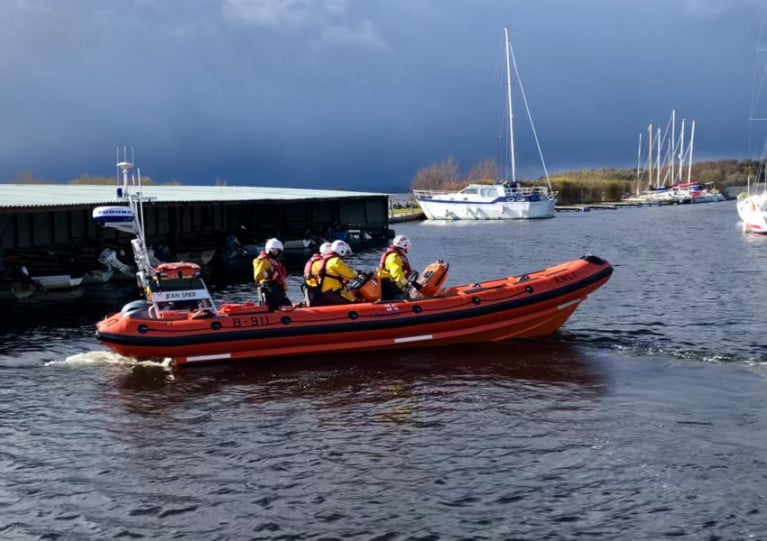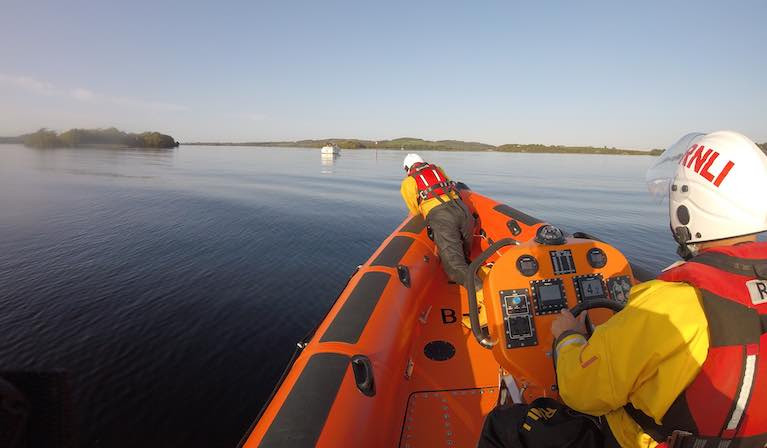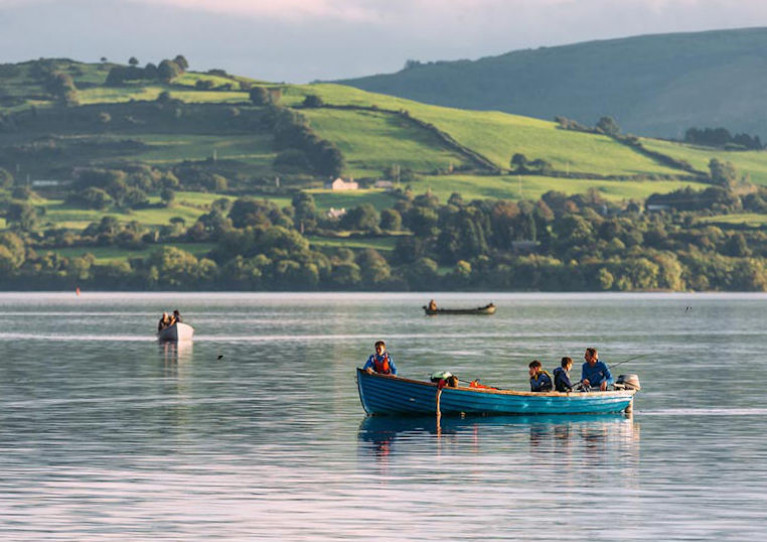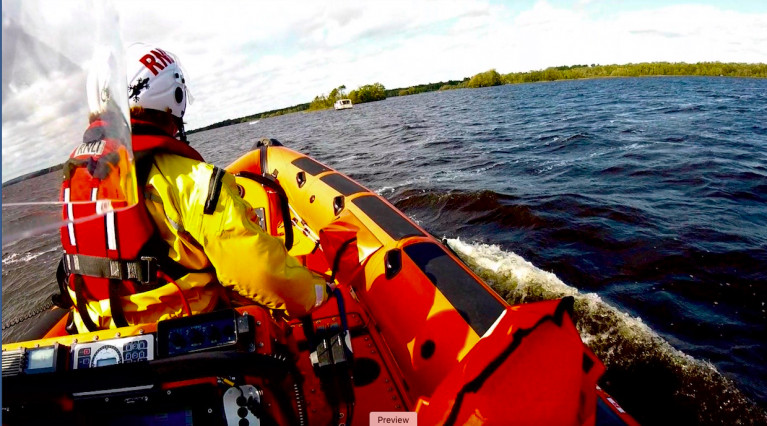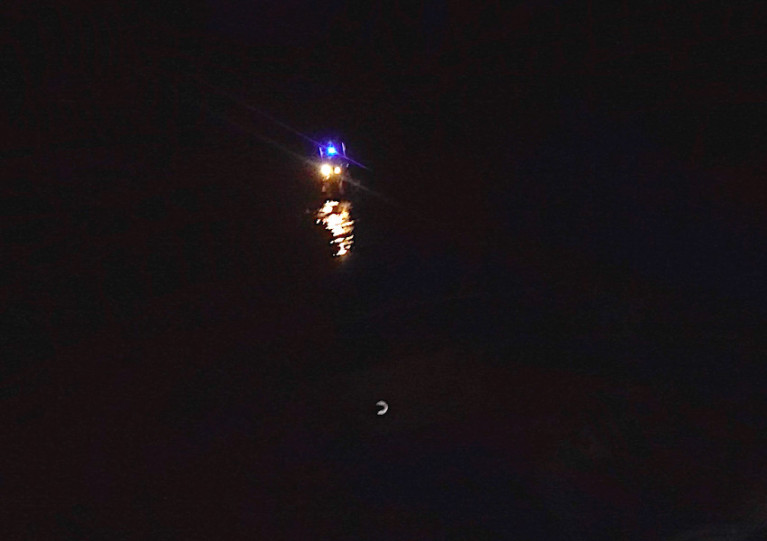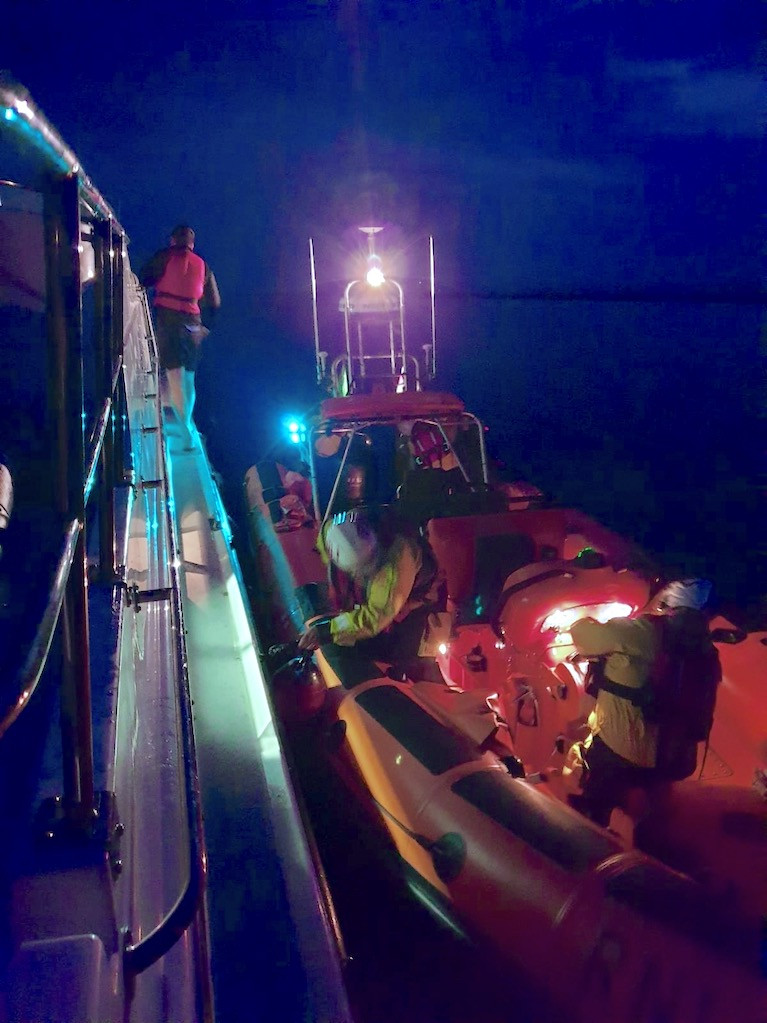Displaying items by tag: Lough Derg
Tuesday 13 October at 8pm is the date and time for your TV diary to see the volunteer crew of Lough Derg RNLI feature in the current series of Saving Lives at Sea on BBC Two.
Viewers will see Lough Derg’s lifeboat crew rescue a man who fell overboard in rough weather and an eerie night time launch in fog, alongside rescue stories from their colleagues at other stations and beaches around our coasts.
Saving Lives at Sea features real-life rescue footage captured on helmet cameras gives a frontline view of how the RNLI’s lifesavers risk their own lives as they go to the aid of those in danger at sea.
That’s accompanied by emotive interviews from the volunteer lifeboat crews and lifeguards from around Ireland and the UK, alongside the people they rescue and their families.
Lough Derg’s upcoming profile follows on from Lough Ree lifesavers’ appearance in last year’s series of the hit TV documentary, as previously reported on Afloat.ie.
And in next week's episode, the volunteer crew of Skerries RNLI will feature with their rescue of a teenage paddle boarder who was blown out to sea.
“It’s great that we can showcase the lifesaving work of RNLI volunteers in a TV programme like this,” said Lough Derg helm Eleanor Hooker.
“In recent months, the pandemic has presented RNLI volunteers with additional challenges, but we’ve continued to maintain a 24/7 search and rescue service.
“This year, due to Covid, fundraising events have been cancelled and we’ve seen a drop in our charitable income. Without the generous support and donations from the public, we wouldn’t be able to save lives at sea.
“It’s great that with the Saving Lives at Sea programme our supporters can see what we do out on a shout, and from the comfort of their own home. We need their support more than ever during these challenging times.”
Saving Lives at Sea is broadcast Tuesdays at 8pm on BBC Two, NI, and viewers in the UK can also watch the series on demand following broadcast on the BBC iPlayer.
Lough Derg RNLI Assists Four Adults on a 30-ft Cruiser Aground
Lough Derg RNLI assisted four adults on a 30-ft cruiser aground at Skehanagh, on eastern, Tipperary shore, of Lough Derg behind Illaunmor.
At 5.15 pm this afternoon, Sunday, September 20, as Lough Derg RNLI volunteers were arriving for a training exercise, Valentia Coast Guard requested the lifeboat to launch to assist 4 people on a 30ft cruiser, who reported their boat aground by Dromaan Harbour on the County Clare Shore.
At 5.19 pm the lifeboat Jean Spier launched with helm Owen Cavanagh, crew Keith Brennan and Tom Hayes on board. Visibility was very good, and the lake flat calm.
When the cruiser was not located at Dromaan Harbour, Valentia Coast Guard supplied the lifeboat with the telephone number for the casualty vessel.
Lifeboat crew asked the casualties to describe what they could see around them, and from their descriptions, the lifeboat volunteers accurately determined that they were at Skehanagh, north of Illaunmor on the Tipperary shore.
When the lifeboat arrived on scene they found all on board safe and unharmed and wearing their lifejackets. An RNLI volunteer transferred across to the casualty vessel. Once he was satisfied that the vessel was not holed, he set up for a tow.
The lifeboat took the cruiser off the rocks and out into safe water, where an RNLI volunteer checked that its drives and rudder were in good working order.
The lifeboat took their crew member back onto the lifeboat and the cruiser continued its passage.
The lifeboat departed the scene at 6.26 pm and was back at station at 6.33 pm.
Liam Maloney, Lifeboat Operations Manager at Lough Derg RNLI advises boat users to ‘study your charts and stay on the navigation channel when passage planning.’
Caution Advised On Lough Derg As Navigation Marker Near Mountshannon Off Station
Waterways Ireland advises all masters of vessels and water users on Lough Derg to proceed with caution moving in or out of Mountshannon as the green navigation marker for the western side of Cribby Island is currently off station.
Lough Derg has seen a rise in rescue callouts to cruisers in distress over recent weeks amid a boom in the Shannon cruiser hire industry driven by late summer ‘staycations’ on the waterways, as previously reported on Afloat.ie.
Two Callouts for Lough Derg RNLI Including a Vessel Taking on Water in Rough Weather
Two callouts for Lough Derg RNLI today – the first to two people on a 32ft cruiser aground by the Silver Islands on the Galway shore at the northern end of Lough Derg, and shortly after, a Mayday call to four people on board a 16ft motorboat taking on water in rough weather south of Parker’s Point on the southwestern end of the lake.
At 1.06 pm this afternoon, Sunday, September 13, Valentia Coast Guard requested Lough Derg RNLI lifeboat Jean Spier to assist 2 people on a 32ft cruiser reported to be aground by the Silver Islands, inside the red marker ‘Juliet’.
At 1.20 pm the lifeboat launched with helm Eleanor Hooker and crew Steve Smyth, Doireann Kennedy and Chris Parker on board. Visibility was good, and the wind was southwesterly Force 4, gusting Force 5.
As the lifeboat approached Cloondavaun Bay, the volunteer crew could see three vessels on standby in safe water monitoring the casualty vessel.
The lifeboat boat rounded the red navigation mark ‘Juliet’ and, as the water level on the lake is currently lower than usual, navigated a slow, safe route to the casualty vessel.
The lifeboat was alongside the casualty vessel at 1.46 pm. Both people on board were safe and unharmed and wearing their lifejackets. An RNLI volunteer transferred to the casualty vessel. Once he was satisfied that the vessel was not holed, he set up for a tow.
At 1.59 pm the lifeboat had the cruiser off the rocks and towed out into safe water where drives and rudder were checked and found to be in good working order.
The lifeboat took their crew member back onto the lifeboat and the cruiser made it’s way safely to Cloondavaun Bay Harbour
The lifeboat departed the scene and was back at station at 2.25 pm.
At 4.30 pm Valentia Coast Guard requested Lough Derg RNLI to assist 4 people on a 16ft motorboat taking on water in rough weather, and in danger of sinking. At 4.40 pm Lough Derg RNLI launched with helm Eleanor Hooker and crew Ger Egan, Doireann Kennedy and Tom Hayes on board. Winds were southwesterly, Force 5 with a moderate chop.
Given the critical nature of the launch, Rescue 115, the Irish Coast Guard Search and Rescue Helicopter took off from their base at Shannon Airport and Killaloe Coast Guard also launched from their base in Killaloe.
As the lifeboat approached Parker’s Point, Rescue 115 hailed the lifeboat to say they had located the casualty vessel and were going to hover close by. At 4.56 pm the lifeboat was alongside the casualty vessel. All four persons were unharmed and wearing their lifejackets. The had deployed their anchor which was holding them off the rocky shore.
Due to the swell swamping their deck, the casualty vessel had taken on a significant amount of water, which the crew were bailing from the bilge. At this time Killaloe Coast Guard arrived on scene and as the casualty vessel’s base was at Killaloe, it was agreed with Valentia Coast Guard that Killaloe Coast Guard would take the casualty vessel back to Killaloe.
Rescue 115 departed the scene to return to its base at Shannon. Lough Derg RNLI departed the scene was back at Station in Dromineer at 5.20 pm.
Peter Kennedy, Deputy Launching Authority at Lough Derg RNLI praised all the RNLI volunteers for their ‘swift response to the callout. Four people were reported to be in grave and imminent danger, and the efficient shore crew assistance was particularly crucial to a speedy launch of the lifeboat under these circumstances.’
Staycation Trend Proves Boon For Shannon Cruiser Hire Industry
Cruiser hire firms on the River Shannon have experienced a boom in business from ‘staycationers’ as holidays abroad this year were cancelled in droves, according to RTÉ News.
While some operators felt the brunt of coronavirus restrictions in the spring as they lost a lucrative international market, come summer the tide turned and now the industry as a whole says it is enjoying its most successful period in eight years.
Demand has been driven by a hungry domestic market grounded by lockdowns on foreign getaways — with RTÉ News highlighting Banagher in particular at its busiest this month.
And it’s hoped many of those who may be new to a cruising holiday, or other aquatic activities on Ireland’s inland waterways, will be hooked enough to return next season.
?️ It has been a bumper season for the cruiser market on the River Shannon, as people continue to holiday at home during the pandemic. Traffic on the river is up by over 30%, and Waterways Ireland says the new business will help secure jobs. | Read more: https://t.co/oSmOi9XSUV pic.twitter.com/bqV6DZhI4G
— RTÉ News (@rtenews) September 6, 2020
Meanwhile, the Shannon cruising boom has come alongside a rise in incidents involving cruisers getting into difficulty — with Lough Derg RNLI having a particularly busy week.
Most recently the inshore lifeboat Jean Spicer was called to a 36ft cruiser with four on board which ran aground in Youghal Bay on Thursday evening (10 September).
This followed rescues for a 20ft vessel with engine failure at the lough’s northeastern end on Wednesday; a 35ft cruiser aground by the Silver Islands on Monday evening; and a vessel with engine failure near Mountshannon Harbour last Sunday.
Also on Sunday, four people were rescued from a Shannon cruiser that caught fire and sank after difficulties in the Jamestown Canal.
The RNLI has repeated its call for all boat users, many of whom may be new to cruising or boating, to study their charts and stay on the navigation route.
Boaters should also ensure their engines are fully serviced, and that they have sufficient fuel for any journey — while lifejackets must be worn by everyone on board.
Lough Derg Lifeboat Launches To Cruiser Adrift In Reeds
A busy week for Lough Derg RNLI’s lifeboat volunteers continued on Tuesday night (8 September) after a 20ft cruiser suffered engine failure at the lough’s northeastern end.
The lifeboat Jean Spicer launched just before 9.20pm and used all onboard electronic navigation aids to locate cruiser, which was adrift by Bellevue Point.
On request, the three people on board the cruiser flashed a light for the lifeboat crew as they approached, and great care was taken to bring the lifeboat alongside the casualty vessel which had drifted into reeds close to the shore.
All on board were dafe and unharmed, and the motorboat was brought under tow to Dromineer Harbour.
Deputy launching authority Peter Kennedy advises boat users to “make sure your engines are fully serviced, and that you have sufficient fuel for your journey.
“Always carry enough lifejackets for everyone on board and that they are worn.”
The callout marked the third to a cruiser in difficulty in as many days for the Lough Derg crew — following a 35ft cruiser aground by the Silver Islands on Monday evening (7 September) and a vessel with engine failure near Mountshannon Harbour on Sunday (6 September).
Lough Derg RNLI Assist 35ft-Cruiser Aground By the Silver Islands on Galway Shore
At 8.25 pm this evening, Monday, September 7, Valentia Coast Guard requested Lough Derg RNLI lifeboat Jean Spier to assist 4 people on a 35ft cruiser reported to be aground near Terryglass Bay.
At 8.47 pm the lifeboat launched with helm Eleanor Hooker and crew Owen Cavanagh, Keith Brennan and Chris Parker on board. It was nightfall, so the crew used their onboard electronic navigation, RADAR, searchlights, night vision binoculars and local knowledge as adjuncts to navigation. Winds were southwesterly, Force 4 gusting 5.
As the lifeboat approached Terryglass Bay, volunteer crew could see a flashing light signal ahead. Valentia Coast Guard provided the lifeboat crew with a contact telephone number for the casualty vessel.
The casualty vessel confirmed it was their boat emitting the light signal. To determine the aspect of the casualty vessel, the lifeboat crew asked from which direction the vessel had been travelling when it went aground, and whether they were looking at the lifeboat travelling in their direction from the bow or stern of their vessel.
The lifeboat made way to the red marker by Rinmaher Point on the Galway shore, and after rounding it, took soundings of the depth to the casualty vessel.
The lifeboat was alongside the casualty vessel at 9.06 pm. All four people on board were safe and unharmed and wearing their lifejackets. An RNLI volunteer transferred to the casualty vessel. Once he was satisfied that the vessel was not holed, he set up for a tow.
The lifeboat took the cruiser off the rocks and out into safe water where drives and rudder were checked and found to be in good working order.
With an RNLI volunteer remaining on the casualty vessel with her four passengers, the cruiser followed the lifeboat across the bay into Terryglass Harbour, the safest closest harbour, where it was safely tied alongside at 10.08 pm.
The lifeboat departed the scene and was back at station at 10.50 pm.
Christine O’Malley, Deputy Launching Authority at Lough Derg RNLI advises boat users to ‘study your charts and for your safety, plan your passage so that you arrive at your destination before nightfall’.
Lough Derg Lifeboat Launches To Cruiser With Engine Failure
Lough Derg RNLI volunteers were tasked to the aid of two people on a cruiser which engine failure near Mountshanon Harbour yesterday afternoon, Sunday 6 September.
The inshore lifeboat Jean Spicer diverted from a training exercise just before 2pm and made way to the reported location.
With no vessel in sight, the lifeboat crew made radio contact with the stricken vessel, which it turned out had drifted close to rocks east of the Scilly Isles.
The two on board the 27ft cruiser were safe and unharmed, and wearing lifejackets.
A lifeboat crew member was put aboard and discerned that the cruiser has suffered a gearbox failure.
A tow was then set up to bring the broken down vessel back to Mountshannon Harbour, and within an hour the lifeboat had returned to Dromineer Bay to complete its exercise.
‘Even on the calmest days, inflatable toys are not fit for the conditions you will experience along our coastline’
Elsewhere on Sunday afternoon, Arklow RNLI’s all-weather lifeboat Ger Tigchlearr launched to reports of a person in difficulty in a small inflatable boat off Mizen Head.
Once the crew was on scene, the individual tried to make his way back to shore while the lifeboat stood by.
But the rocky coastline and prevailing tidal conditions made this difficult, so it was agreed the safest option was to take the person on board the lifeboat.
Following the incident, Arklow RNLI’s community safety officer Mark Corcoran said: “Thankfully this afternoon was relatively calm, had conditions been worse the situation might not have ended so well.
“In recent weeks there has been a lot of rescues all around our coastline of people from small inflatable boats and toys.
“We’d like to remind people of the real risk of drowning when you go to sea on vessels of this nature, even on the calmest days these types of boats and toys are not fit for the conditions you will experience along our coastline.”
Claims of speeding RIBs and jet skis over the weekend have prompted a call for a no-wake notice for Terryglass Harbour on Lough Derg.
One boater said the powered vessels caused “large wakes in very close proximity to moored cruisers on the concrete jetty, causing sustained and substantial discomfort for these boats and their crews throughout the weekend”.
No wake zones have been established elsewhere on Ireland’s inland waterways, most recently at Newferry on the Lower Bann were vessels must proceed at a slow speed when passing the jetties and slipways.
Lough Derg RNLI Assist Eight People on Cruiser Aground
At 9.28 pm last night, Thursday, August 13, Valentia Coast Guard requested Lough Derg RNLI to go to the assistance of 8 adults on a 45ft cruiser aground by Ryan’s Point, inside the Mountaineer Bouy at Barrack Bay.
At 9.42 pm the RNLI lifeboat Jean Spier launched with helm Eleanor Hooker, and crew members Owen Cavanagh, Keith Brennan and Doireann Kennedy on board. The wind was northeasterly, Force 2. It was nightfall with poor visibility; the RNLI volunteers used on-board electronic navigation, RADAR, searchlights and local knowledge to steer their course to the casualty.
Once the lifeboat rounded the Mountaineer Buoy, the crew took soundings of the depths in a cautious approach to the casualty vessel. The lifeboat came alongside at 9.55 pm and found all eight people to be safe and unharmed and wearing their lifejackets.
An RNLI volunteer transferred to the cruiser. Once he was satisfied that the vessel was not holed, he set up for a tow. The lifeboat attempted to take the casualty vessel astern off the rocky shelf. However, it was stuck fast on the rocks.
As the cruiser had been travelling in company, and its companion vessel was moored in Garrykennedy Harbour, the lifeboat informed Valentia Coast Guard of its intention to take all passengers on to the lifeboat and to bring them to Garrykennedy Harbour for the night.
Valentia Coast Guard arranged for the casualty vessel to be attended to first thing the following morning.
At 11.04 pm the lifeboat delivered the eight people into to the care of their friends at Garrykennedy Harbour.
The lifeboat departed the scene and was back at Station at 11.30 pm
Peter Kennedy, Deputy Launching Authority at Lough Derg RNLI advises boat users to ‘study your charts and plan your passage, paying close attention to the navigation buoys’.



























